
The history & Geography of Human Genes
L. Luca Cavalli-Sforza, Paolo Menozzi, and Alberto Piazza
Book Review
By Saam Shams,
February 19 2022
Summary:
The following is a comprehensive review of this book. The sheer volume of information made writing this review difficult as a significant amount of data reduction and compression was necessary. Nevertheless, I found the book absolutely fascinating and learned a significant amount of information that I had previously not known about the origins of the Human species and the history of the different races that still exist to this day. I am convinced humans will merge into a more singular race given our current technologies and development of civilization, so this information is more to appreciate our shared history and a curiosity that despite many thousand years of separation (over 50,000 years in the case of Australian aborigines and Africans) we are still a single species and capable of producing offspring even with partners of the farthest genetic distances.
Chapter 1: Introduction to Concepts, Data, and Methods
This chapter covers the details of how and what specific genetic data is measured to produce metrics such as “genetic distance” in order to obtain the genetic relationships between different human populations. One important concept that is defined is mutation. Mutation is defined as a “transmission error in the reproduction of DNA”. Furthermore, mutation is a key and required ingredient of evolution. Ironically “transmission error” is necessary for evolution to exist, which suggests that we exist because of error. Besides mutation, evolution is also a product of migration, natural selection, and random genetic drift.
Section 1.5 discusses attempts to distinguish between different human races. This quote perhaps best summarizes the attempt of racial classification, “Human races are still extremely unstable entities in the hands of modern taxonomists, who define from 3 to 60 or more races (Garn 1971)”. Furthermore, “All population or population clusters overlap when single genes are considered, and in almost all populations, all alleles are present but in different frequencies. No single gene is therefore sufficient for classifying human populations into systematic categories.” The book eventually adopts the three principle divisions of humanity as Negroid, Caucasoid, and Mongoloid, where Negroid principally defines the people of south and central Africa, Caucasoid the people extending from Northern Africa to Europe to Central Asia, and Mongoloid for the rest of humanity whom expanded eastward of Central Asia. There does appear to be sufficient physical and genetic differences between these three geographies to support this categorization, at least at the time of the writing of this book.
“The morphological traits vary more in Caucasoids than in Mongoloids: for instance, there is a wider range of skin color from extreme white in northern Europe to black in southern Indian than there is in Mongoloids, who vary less from north to south. Hair in Caucasoids varies from blonde to black and can be straight or wavy, whereas it is almost invariably black, straight, and coarse in Mongoloids. Mongoloids also have scarce facial and body hair, and graying is delayed, whereas hair is abundant in Caucasoids and graying is almost the rule.” “The origin of Mongoloids is believed to be either in Northern China or north of it.” Mongoloid features, mostly reflected in the conformation of the skull and soft parts of the face, which include large cranial and facial dimensions, flattened face, nasal bones and nasal bridge. Like most Mongoloids (with the exception of the Ainu), they have very little, if any, body and facial hair, but abundant and coarse dark hair with rare balding and late, if any, graying. Most northern Mongoloids have shovel-shaped incisors, which are found in fossil skulls as far back as Chinese Homo erectus. This and other cranial peculiarities have been a major reason for claiming independent speciation of Mongoloids.
The two most distant populations on the planet are shown to be that of the Native Australians and Africans. This supports the theory that humans initially expanded out from Africa. A fascinating thought is expressed in the following statement, “One fairly widely accepted conclusion (Goodman 1985) is that there has been a slowdown in the evolution of hominoids compared, for example, with that of rodents and equines. A reasonable explanation is that hominoids have unusually long generation times, causing lower mutation rates per unit of astronomical time.” This is a fascinating thought, and makes me wonder if are consciously choosing to stop our own evolution by trying to live longer and longer. Perhaps we think we are perfect and do not want to evolve?
Throughout the book Genetic Trees and Principal Component Maps/Graphs are used to group different ethnic groups based on “Genetic Distance” measurements. The details of which genes and how these measurements are performed are described in detail in this section, which I will not summarize here in this review.
Chapter 2: Genetic History of World Populations
This chapter begins with the beginnings of mankind. Human beings belong to the genus “Homo”. “The history of the genus Homo begins around 2.5 million years ago; and the divergence of modern humans among themselves may be only 100,000 years old...” The chart below (not sure who to credit) is a great visual diagram showing the last 5 million years of our family tree.
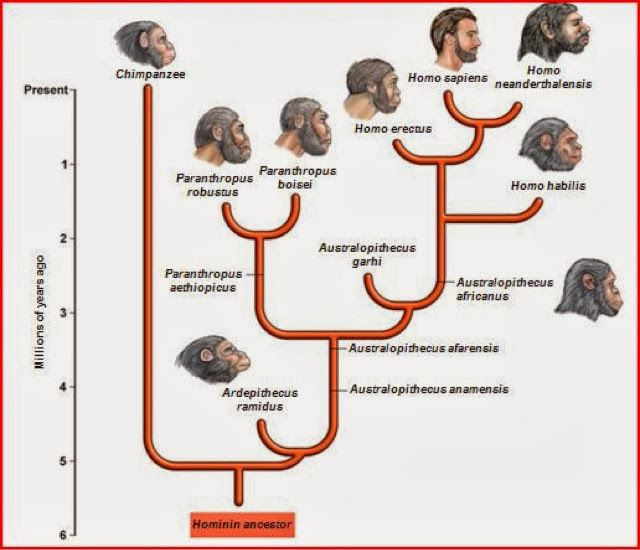
Homo habilis:
- Found only in Africa
- Lived between 2.5 and 1.5 million years ago
- Brains are less than half the size of modern humans
- Capable of making tools
Homo erectus:
- Lived from 1.5 to 0.3 million years ago
- Expanded from Africa to Europe and Asia
Homo Sapiens:
- Reach Europe by at least 300,000 years ago
- At first show no dramatic evidence of behavioral progress with respect to H. erectus (Klein 1989b)
- Same brain size as modern humans
- Includes sub-species Neanderthals
- The Neanderthal brain was a litter larger than modern human brains
Homo Sapiens Sapiens (a.k.a. Anatomically Modern Humans)
- The nearly simultaneous disappearance of Neanderthals in various parts of Europe, coincided approximately with the first appearance of modern humans.
- Widely considered to originate just before 100,000 years ago in East and South Africa, but DNA research suggests could be as old as 200,000 years ago
- The first appearance outside of Africa is in the Middle East, potentially as far back as 100,000 years based on recent findings in Israel
- Evidence of existing in China (at Liujiang) as far back as 67,000 years ago
- Evidence of reaching Australia 55,000 years ago
- Earliest evidence in Europe is between 35,000 to 40,000 years ago
Did modern humans mix with early human types?
The answer is likely yes
“Barriers to fertility are usually slow to develop, and interspecific differences barring interfertility may take a long time, perhaps a million years or more in mammals, on the average.” Plus modern DNA testing suggests Neanderthal DNA exists among modern humans.



Modern Human Populations
The most complete analysis on the three most highly investigated populations representative of the three major ethic groups (mainly British for Europeans, mainly Japanese for East Asians, and mainly from Nigeria and Cameroon for Africans) was published recently (Nei and Livshits 1989). These authors concluded that they have for the first time shown that Europeans and Asians are significantly closer to each other than to Africans. However, evidence suggests that “Europeans (and other Caucasoids) have an intermediate position between Africans and the rest of the world”. This most important conclusion in this section is that “the greatest difference within the human species is between Africans and non-Africans.” This supports the theory that humans originated from Africa and spread out from there.




Measuring Human Origins via DNA
“There is absolutely no evidence from mtDNA work that the human population went through a bottleneck in which there was only one (or a few) women”. “Thus, although all mtDNA present today can be traced to a single common ancestor, this is not evidence that the human population went through a period when only one woman was alive and reproducing. The same is true for the Y chromosome.” Research of mtDNA suggests an ancestral origin of modern humans of roughly 200,000 years ago. This fits in reasonably well with the earliest finding of remains dated around 130,000 years ago.
Original Human Group
Section 2.4.b shows the DNA sequencing of Chimps, and all major human groups. The results shown suggest that the Khoisan people of Africa are most closely related to the original human group from which all others have derived. However, further work is necessary to remove the uncertainties of this analysis.
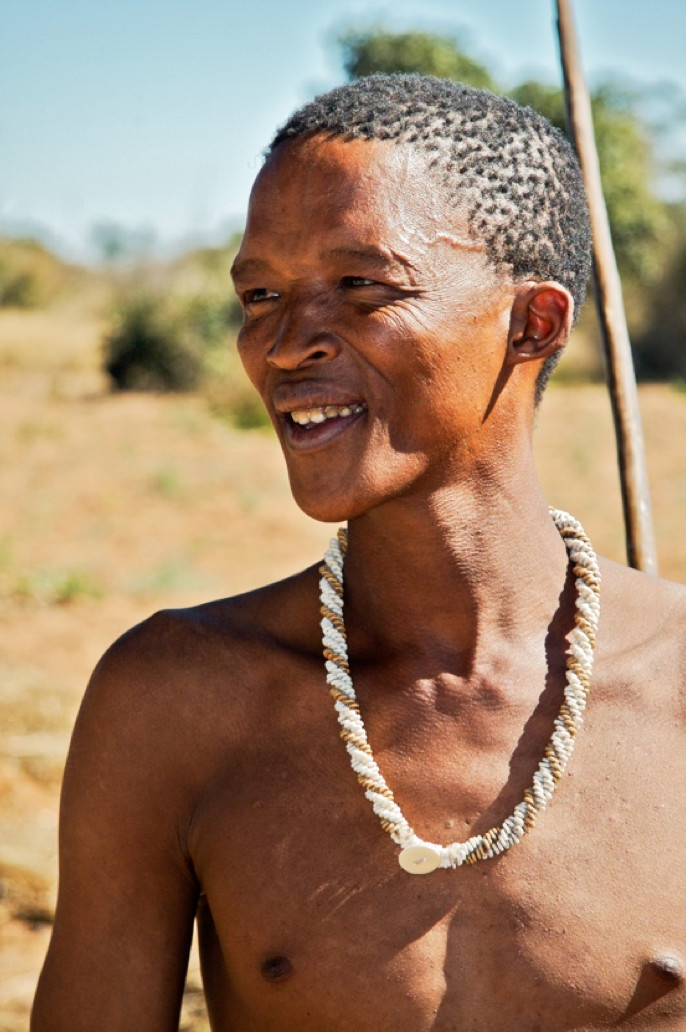



Evolution of Human Languages and Connections with Race
Each of the next chapters focus on a specific continent and/or region of the world inhabited by humans. The specific details on the languages of each region are presented in each of these chapters. Below is a map and genetic tree of the general lingual classifications of the world.
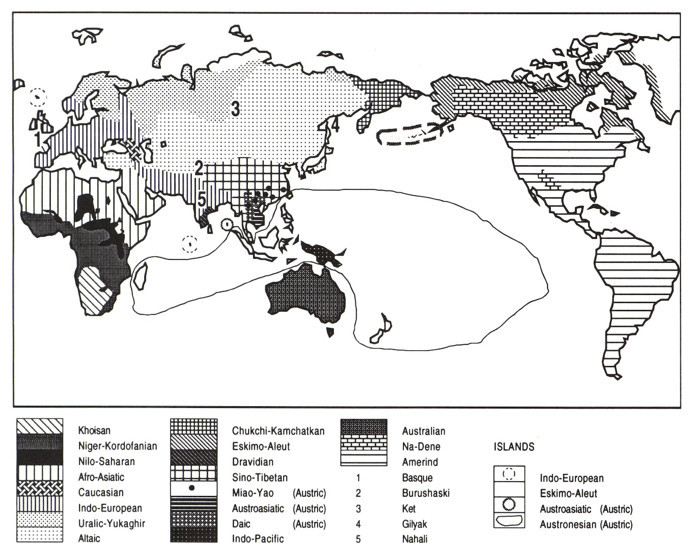

Civilization
The development of cities. Civilization is derived from the Latin cevitas, meaning city. Civilizations properly developed after the development of agriculture, different regions had different base crops that formed the foundation of the civilization. This is evident even to this day, where some cultures appear to heavily use wheat, corn, another base crop such as rice.

Chapter 3 - Africa
Approximately 1,400 language are spoken today in Africa, about one-fourth of all the world’s languages. Africa was a very populous continent, probably second only to Asia until 4,000-5,000 B.C., after which it was surpassed by Europe. The banana was imported to East Africa from an unknown origin in Asia and had a major impact on population growth during the Iron Age.
Africans are separated into 4 major ethnic groups
- Use of the “click” sound in language
- Were hunter-gatherers at the time of the arrival of the first farmers in South Africa
- Approximately 120,000 speakers of the 30 Khoisan languages today
- More than 1,000 languages and 180 million speakers
- Very complex group with many tribes
- 140 languages and 11 million speakers
- Includes various people, pastoral nomads like the Nilotic and Maasai in Kenya.
- 240 languages, confined to Northern and Eastern Africa
- 5 Major language branches including the now extinct Ancient Egyptian
- Berber – Spoken in much of North Africa
- Chadic – Spoken by pastoral nomads and traders in the Sahel
- Omotic – Spoken by a small region in Ethiopia
- Cushitic – Spoken in most of Ethiopia
- Semitic – Spoken in all of Arabia, North Africa, and much of Middle East
Khoisan
Niger-Kordofanian
Nilo-Saharan
Afro-Asiatic

“Today the continent is inhabited by two major aboriginal groups, Caucasoids in the north almost down to the Southern border of the Sahara, and Negroids in sub-Saharan Africa. In the east, however, and especially in Ethiopia and Somalia, people have lighter skin and are considered Negroid by some, Caucasoid by others. The Negroid type is not homogeneous: the classification by Hiernaux (1975) distinguished five groups (Bushmen, Pygmies and Pygmoids, elongated Africans, West African, and Bantu). It remains difficult to pinpoint an ancient place of origin for the Negroid type, which includes all West, Central and South Africans. Contrary to many earlier opinions, modern Pygmies and Khoisans are not good candidates for a proto-African population. Altogether, Pygmies, Bantu, West Africans, and Nilo-Saharan peoples are all potential representatives of the modern African type.
Pygmies live in Central Africa, are mostly inhabitants of the tropical forest, and are adapted to a humid climate; they have a small stature that increases the ratio of surface to volume and allows them to take better advantage of the cooling effect of perspiration; in addition their small mass means that their internal heat production is lower than that of larger people. The smallest Pygmy trip has an average height of 145 cm (4’ 9”) in males and 137 cm (4’ 6”) in females. Pygmies have normal levels of growth hormone, but lower levels of growth-hormone receptor (GHR) and insulin like growth factor I (IGFI); the latter remains low during adolescence, while in non-Pygmy individuals, IGFI increases about threefold. The Pygmies that are the most different genetically from the remainder of the pygmies and other Africans are also the smallest in stature, the Mbuti. Their separation time from other Africans would be about 18,000 years ago. During the times of Ancient Egypt, Pygmies were valued by the pharaohs because of their dancing skills, which are famous to this day in much of Central Africa.



Chapter 4 Asia
Asia is the largest continent and “at the center of the world both geographically and historically.”
There is no evidence of human occupation of Siberia until roughly 35,000 years ago.
The development of Pastoral Nomadism in the Central Asian Steppes
The Steppes of central Asia has proven to be a region of migration for different groups of humans, both pre and post the time of historical records. It is a relatively flat and arid region which allows for relatively fast transportation. “The migrations, often seasonal, can range from 20 to 1000 miles or more and may last many months.”
4,000 B.C. – Use of goats, sheep, and cattle
3,000 B.C. – Camel and Horse used for transportation
2,500 B.C – Use of two- and four-wheel horse-powered chariots and burial mounds (Kurgans)
2,000 B.C – Bronze age for the Steppe, enhanced irrigation techniques
“By the 2nd millennium B.C., there may have started some true population explosions of people of the steppe, which continued to generate repeated population waves until the Middle Ages, first of European-looking and Indo-European speaking individuals, then, beginning in the third century B.C., of oriental-looking nomads, speaking languages of the Altaic family.” The penetration of Turkmenia, the Indus Valley, and India by Aryans, probably from the Andronovo and Srubnaya cultures in the first half of the second millennium B.C., may have been among the first expansions of pastoral nomads in Asia (Zvelebil 1980). The Hurri and Mitanni kingdoms in Mespotamia (1500-1300 B.C.) probably had a similar origin. “The culture described in the oldest Aryan texts is similar to that of the steppe nomads.”

Later on, the Steppes became home to Mongoloid cultures. The Huns were probably the first Mongolian nomads, who dominated the Asian Steppes from 300 B.C. to 500 A.D., followed by Turks and Mongol tribes up to the Genghis Khan period. “Although modern Turkey was repeatedly invaded by Turks from the late eleventh century A.D. onward, what little genetic evidence is available does not seem to support a major genetic contribution by the invaders.” I think it is interesting to note that of all the nations in the world that speak a language within the Turkish family of languages, the one with the name “Turkey” is likely the least genetically Turkish of them all. It makes you question the link between culture and genes.
East Asia
Japan was not an island when humans first encountered East Asia. It was connected almost entirely both through the North and South, and only became an island with rising sea levels between 10,000 and 7,000 years ago. There are signs of human occupation dating back to 30,000 years ago near Tokyo (Glover 1980). The oldest known evidence of pottery is found in Japan, dating back to 12,700 years ago. Domesticated dogs appear by 7000 B.C., and boats with paddles from 5000 to 4000 B.C. Pottery appeared before agriculture in East Asia. Tibetan populations are historically of northern Chinese origin.


China is one of the few places on the planet that shows signs of human habitation in the lower Paleolithic. A find of a subspecies under Homo erectus was made recently at Lantian that may date between 600,000 and 1 million years ago. No Neanderthal remains have been found in China, the nearest one being found in Central Asia (Uzbekistan). Modern human fossils have also been found. Finds in the upper Zhoukoudian cave date to between 11,000 and 18,000 years ago. Morphometric analysis (Howells 1981) suggests that the skulls are more similar to that of American Indians than to those of the modern Chinese. The theory of a co-evolution from homo-erectus to modern humans in different locations is popular in China, despite not being supported from genetic data. This view may be popular due to interests in identifying China as an origination point for the Chinese identity in a political context. However, it is possible to hypothesis that there was admixture of expanding humans and local archaic Homo sapiens groups. There is evidence for the domestication of the pig and dog between 6,500 and 8,500 years ago. Tombs with female skeletons were much richer than those of males, suggesting a matriarchal culture that continued in China, at least until the first millennium B.C. “Modern humans seem to have appeared in China relatively late and fairly abruptly…”
India
The genetic history of India is linked to early humans who left Africa, early Dravidian speakers who settled in the area during the rise of agriculture and civilization in the region, as well as Aryan pastoral nomads who came in later and had a significant impact on the society and culture. “Linking the two series of events in Turkmenia and the Indus Valley, it seems very likely that both were due to the takeover of power by Aryan pastoral nomads who came from the steppes of Central Asia, spoke an Indo-European language, and used iron and horses (Masson and Sarianidi 1972). “The events accompanying the arrival of the Aryan pastoral nomads from the oases of Central Asia are probably better described as a migration rather than a conquest or invasion, but pastoral nomads clearly introduced a social stratification and segmentation of all India based on religion and politics, in which they took the upper classes.” “Dravidians, although clustering together, do not separate from Indo-European speakers at first or second fission. This indicates considerable admixture. Although Indo-European speakers are found in the whole subcontinent, their genes must have been considerably diluted as they went through the center and the south.”
The several tribes of the Andaman Islands who are still hunter-gatherers likely represent relics of the human bridge that may have existed 60,000 to 70,000 years ago, between Africa and Australia.

West Asia
Almost all important animals like cattle, sheep, goats, and pigs seem to have been domesticated first in the Middle East. At the end of the last glacial age favored the growth of grasses, the regions of the Middle East, Turkey, and Iran developed rich stands of wild cereals like wheat and barley, progenitors of the modern cultivated varieties. The original wild plant that is the origin of wheat is found in southeastern Turkey. Clay houses become common around 10,000 years ago, some still exist to this day after 10,000 years of constant habitation (Arbil in northern Iraq). The earliest known civilization is that of Sumeria, and the language they spoke (Sumerian) is not known to be related to any known language, but shows similarities with Caucasian languages. They used a number system based on a base 6 digits, rather than the modern 10.
The civilization of Elam also developed in southwest Iran, and used a language that is often considered to be related to the Dravidian family, but may be a language isolate. The modern-day name of Armenia is probably the leftover of a Greek misnomer caused by confusion with the Arameans who lived in the same region. Armenians call themselves Hayk, and refer to their own country as Hayastan.

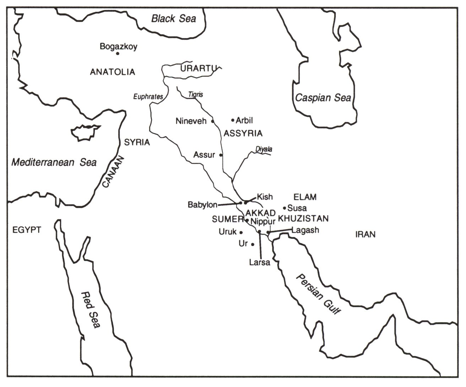
“Arabs separate in the tree from other populations of the Near East.” “It is worth noting that the union of Indic and Iranian or Indo-Iranian is one of the few sub-groupings within Indo-European that is universally accepted, indicating that it probably represents a very late split. Indo-Iranian languages are thus far too similar to have been spread from the Middle East 10,000 years ago. In fact, the migration from Central Asian steppes that led to the settlement in Iran and India may be only about 4,000 years old or less.”
The three major language groups of the Middle east fall into the categories of 1) Afro Asiatic, 2) Indo-European, and 3) Dravidian. Dravidian likely used to be more widely use throughout the region but in modern times is confined to principally to South Asia.


Genetic tree of Asian populations

Chapter 5 - Europe
“Europe, a peninsula of Asia, has been promoted to the status of continent more for historical reasons than for geographic reasons.” Until roughly 40,000 years ago, all humans in Europe were Neanderthals. “The transition from Neanderthal to modern humans is marked by the appearance of people with a new and distinctive skull morphology (called Cro-Magnon) after the site of their discover in France.” “The last regions in Europe to be occupied by humans were the British Isles and Scandinavia.”
The Megalith culture appeared in Europe between 5,000 to 1,000 B.C. The famous Stonehenge is an example of this. After 2,000 B.C. Crete and the Greek mainland became the cultural center of Europe.

The Bell Beaker group (3500-2500 B.C.) is characterized by a distinctive type of pottery that gave the culture its name, also use of single graves, copper, and archery. Also, another culture that included Battle Axes, Corded Ware, and Globular Amphora are distributed in the Scandinavian and Northern Central Europe regions.

The peak of Celtic culture was in the 5th to 3rd century B.C. The Celtic community included southeastern, central, and southwestern Europe. “It’s unity was probably based on a common culture and language rather than genetic kinship.”
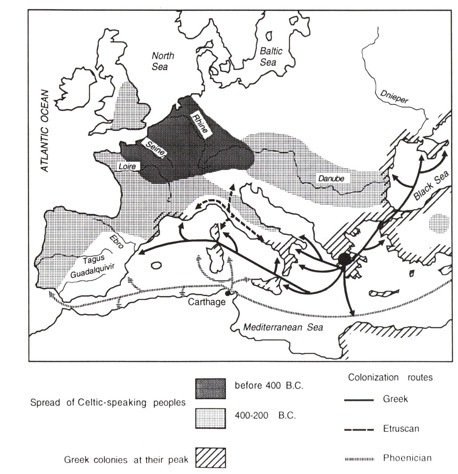
There is some debate on how Indo-European speaking people came to dominate the continent.
There are two major theories of how Indo-European languages spread to Europe:
- Gradual spread of Indo-European speaking farmers from Middle East into Europe 9000-5000 years ago. Supported by Renfrew and Sforza
- More traditional hypothesis that these languages were spread from pastoral nomads around 1,500 B.C. or 3500 years ago.
The author appears to support the view that Indo-European speakers gradually moved into the continent after learning to farm in the Middle East from roughly 9,000 to 5,000 years ago. Another theory suggests that Indo-European speaking pastoral nomads came into the continent from the Central Asian steppes, similar to the Aryan migrations into Iran and India. It is possible however, that both are true, and that the latter migrations of pastoral nomads were also speakers of the same family group. There is no direct evidence of the language spoken by the early farmers of the Middle East.
Archaeologist Gimbutas suggested that there was a westward expansion from the Kurgan area above the Caucasus, of pastoral nomads speaking Indo European Languages. In general population flow into Europe general came from the Caucus region, the expansion of various groups such as the Goths, Huns, Alans, Suevi, and vandals generally show a westward expansion. One of these groups (Germanic, The Visigoths) sacked Rome in 408 A.D.



Iceland
Icelanders came from Norway. “This island was settled beginning in A.D. 874, according to tradition, by wester Norwegians from the region between Trondheim and Bergen, and the settlement was completed in a relatively short time.” The language is still more similar to old Norse than to other Scandinavian languages.
Italy
Northern Italy shows similarities with countries of Central Europe, whereas central and southern Italy are more similar to Greece and other Mediterranean countries. Sardinians are an outlier being most similar to Italians, Lebanese, and North Africans. “The antiquity of Sardinians is stated to be compatible with a date of settlement from southern Europe between 9,000 to 6,000 years ago.”
Switzerland
Another Germanic people (a confederation of german tribes), the alemanni, settled in Alstia and Switzerland and gave their language to these regions. According to Gaius Asinius Quadratus (quoted in the mid 6th century by Byzantine historian Aqathias), the name Alamanni means “all men”. It indicates that they were a conglomerate drawn from various Germanic tribes.
France
The Franks (a Germanic tribe) are also believed to have contributed relatively little genetically to the Parisian Area, which was then already heavily settle by Gallo-Romans, but they developed efficient political control of the region. Altogether the German genetic contribution is estimated to have involved 300,000-350,000 people, or 6-7% of the population of Gaul (Fierro-Domenech 1986). The French language started developing in the early Middle Ages from Latin, first in the Frankish area (north-east), and further evolved as it gradually expanded to the rest of France.
Iberia
“The three main Romance languages of Latin origin spoken in the Iberian peninsula are Galician in the northwest, from which the Portuguese language took its origin; Castilian, originally from the north-central area, from which the Spanish language took its origin; and Catalan, in the northeast.”
“It is believed that Basques were in the present area before the arrival of Neolithics some 6,000 to 7,000 years ago.” Basque language is a language Isolate, but shows some signs of relationship to northern Caucasian languages. “The simplest hypothesis one can make is that Basque was spoken by the local Mesolithics before the arrival of Neolithics, which may have brought the first Indo-European language in the area” “Basques show some genetic similarity with Sardinia and West Asia, especially with the area of the Caucasus (Piazza et al. 1988a).” “Basques are the only European people who can aspire to the privileged position of proto-European.”
The principal component maps of Europe strongly support the theory of an expansion of people from the near east to Europe. “The first synthetic map parallels very closely the map of the times of first arrivals of Neolithic or, archaeologically, of the cultivated forms of cereals domesticated in the Middle East and not present in Europe before the agricultural expansion.”

The second PC map can be explained by the contrast in the Mongoloid components of the Lapp population contrasting with the Caucasoid components of the region.

The third PC map strongly correlates the theory of an expansion of Kurgan (Aryan) culture, or potentially a secondary expansion of Indo-European speaking people entering Europe at a later stage than those who spread earlier from the near east.
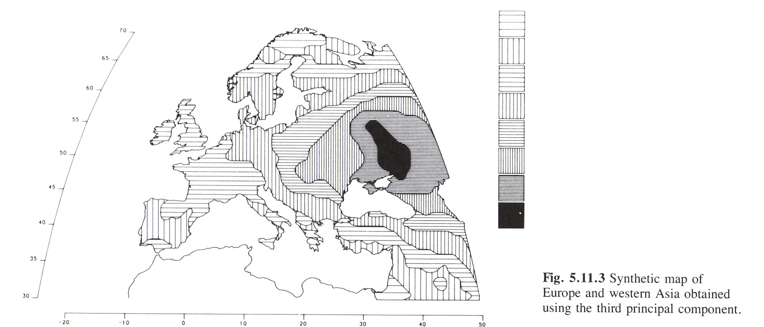
It is difficult to link a cline of gene frequencies with a precise historical expansion “From Herodotus, we know the names of many ethnic groups who migrated to Europe from the east after 500 or 600 B.C. and the approximate areas where they were located before their last movement.” “Most of the groups that came to Europe after the fall of the Roman Empire were probably too small numerically to give a detectable genetic contribution, given that Europe was already fairly densely populated at the time.” For example, the Scythians, who lived in 500 B.C. on the northern shores of the Black Sea, and were sufficiently important in that their hostile initiatives provoked King Darius of Persia, who was unsuccessful to subdue them. The Scythians may have settled relatively late north of the Black Sea, in the area corresponding approximately to the peak of the third PC. They spoke a language, now extinct, of the Iranian subfamily, and their origin is likely to have been from an oasis of the Central Asian Steppes, north of the Caspian Sea.” The Sarmatians had an origin similar to that of the Scythians and conquered them; their contribution to the synthetic maps may be undistinguishable from that of the Scythians. Another group, the Goths, had a similar late arrival to Europe, and despite sacking Rome, probably had little genetic contribution to the continent.
It is important to note that sometimes language replacement has a significant genetic component and sometimes not. “On the basis of present knowledge, Turks seem to have been relatively unsuccessful in making their genetic presence felt, even when they occupied modern Turkey, coming from the East. By contrast the genetic gradient in Europe of people originating from the Middle East is of dramatic magnitude and regularity across the whole continent.”
Origin of Indo-European Family
“The question of the area of origin of Indo-European languages has been studies intensively, and there exist many different hypotheses (Mallory 1989).

The time and origin of the Indo-European family is usually given as 5,000 years ago (Gimbutas 1966; Mallory 1989). Renfrew equates the spread of Indo-European with that of farming from the Middle East, which would put the origin, at the latest, at 10,000 years ago. “Genetic distances indicate a minimum of 9,000 years ago, the date corresponding to the average distance of Europeans, including Iranians, and people in the Near East. An upper limit of 17,000 years ago was obtained on the basis of separation of all Indo-European speakers from Berbers”. The study of the modern geographic distribution of genes in Europe strongly suggests a diffusion from a center of origin in the Middle East, as well as other less important migrations (Menozzi et al. 1978).

Chapter 6 - America
There are two camps of thought on the first arrival time of humans into the American continent. Some believe first arrival was 30-35,000 years ago and other who believe it was 15,000 years ago. “There is no evidence on which agreement has been reached that Alaska was occupied by humans before 15,000 years ago.” “A burial of a husky dated to 11,000 years ago is the oldest northern find of a domesticated dog and may have been connected with the use of dog sleds.” Evidence exists for people living in Chile between 12,000 to 14,000 years ago hunting mammoths.
Evidence is clear that there was more than one migration from Asia into America.
- First Migration - Paleo-Indian Migration – The oldest Migration, ancestors of most Native American peoples, spreading throughout both North and South Continents
- Second Migration – Speakers of the Na-Dene Family (between 15,000 to 10,000 years ago) settled in southern Alaska and the northwester coast of north America.
- Third Migration – Eskimo-Aleut people around 10,000 years ago, occupying Alaska and the northern artic coasts.
- The eastern coast of Greenland was settled by Vikings coming from Norway and Iceland in the ninth or tenth century A.D., but the Viking settlement lost contact with Europe and disappeared in the fifteenth century.
Maize (corn) was domesticated from local plants in Mexico at Tehuacan and Tamaulipas around 9,500 years ago.” Turkey (native to America) was first domesticated in Mexico around 300 B.C. Guinea pigs were first domesticated in Colombia and Peru for meat probably in the last 4,000 years. Agriculture probably spread from Mexico to the south. American Indians are said to be Mongoloid in general and more uniform racially.
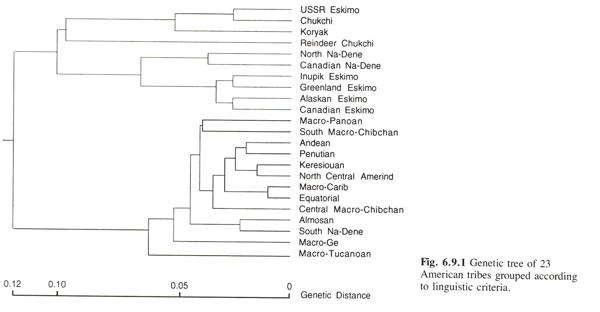
Chapter 7 - Australia + Micronesia/Polynesia
The only known animal brought into Australia by the aborigines was the dingo. Most dingoes are wild, but some have been tamed and used for hunting by the aborigines. The oldest dingo remains in Australia are dated to at least 6000 years ago, however the specific human population which brought them remains unknown. The dingo probably came from Southeast Asia; it competed with the Tasmanian wolf and the Tasmanian devil, both of which are now extinct. At the time of European contact, there probably lived in Australia some 200,000-250,000 aborigines (Jones 1970). In Tasmania, there lived around 4000 people; the last one died in 1876. Disease and genocide have contributed to the thinning and extinction of many aboriginal groups (Diamond 1991a).
The Polynesian colonization of the Pacific took about 2,500 years and was complete by the year 1000 A.D. The Polynesians originated from Taiwan, but had to have come from mainland China before. At the time of European contact, the largest populations were those of the biggest islands or archipelagoes, Hawaii (perhaps 200,000) and New Zealand (100,000-150,000) (Bellwood 1979). It is really amazing how far they managed to migrate but not reach the mainland of the Americas.
